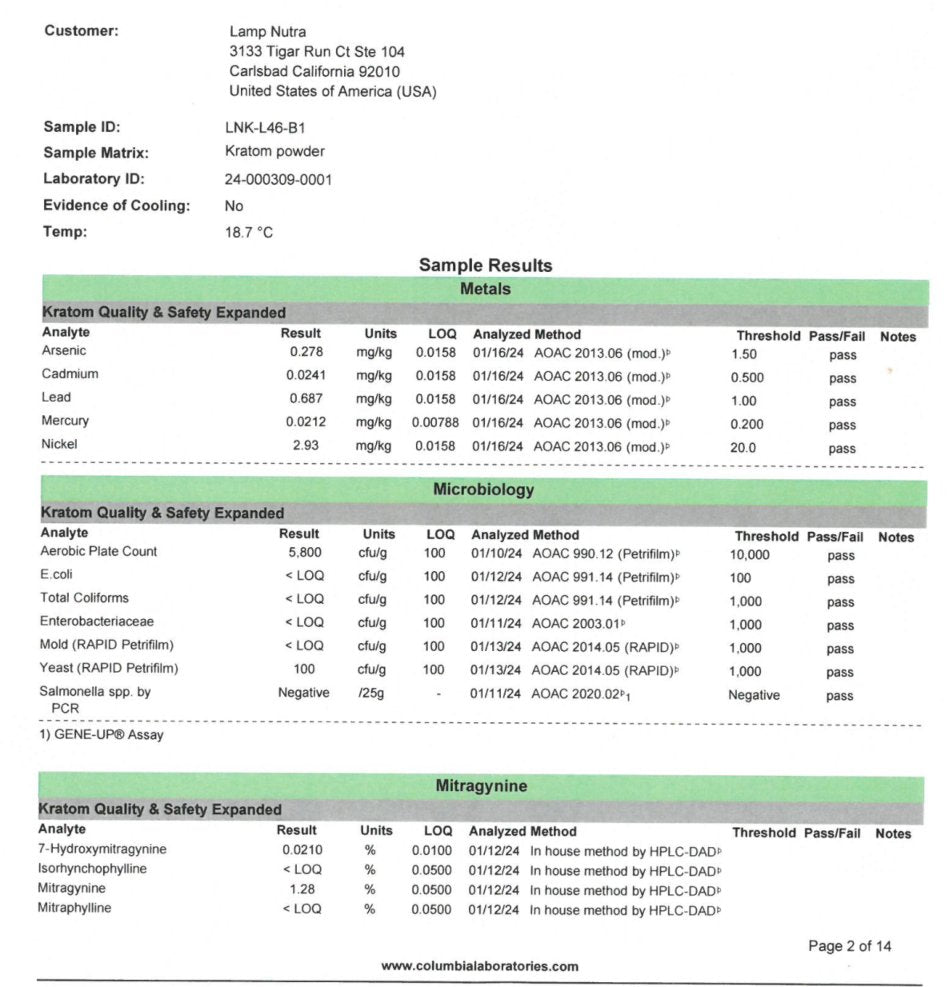If you’re looking to buy kratom online, chances are you’ve seen some online retailers claim to lab-test their kratom and you may have some questions about understanding kratom lab tests. This is a good thing– as a plant product, kratom could be at risk of issues like mold, bacteria, and E. coli. You should never buy kratom that isn’t tested by an independent third-party laboratory.
Lab testing kratom is also vital to understanding the alkaloid levels of every batch, ensuring the products are as advertised. However, the best kratom retailers will publish their kratom lab results online for their customers to check. This way, you can be confident in the kratom products you buy and know exactly what you’re getting. Continue reading for helpful tips on understanding kratom lab tests.

Why Does Kratom Need to be Lab Tested?
One of the best aspects of kratom is that it is all-natural. While that is ultimately a good thing, all plant products are at risk of a few plant-related issues. In the same way the food you eat undergoes testing for common pathogens and high levels of metal content, your kratom needs to be tested as well. Kratom lab results should ensure no toxic levels of mold, bacteria, E. coli, and other plant-related issues. Heavy metals and metalloids are key to important plant development processes and are considered micronutrients. However, these heavy metals may occur in toxic concentrations, and kratom laboratories should be testing to ensure appropriate levels of metal concentrations.
It’s important to note that any plant product is likely to contain trace levels of heavy metals or pathogens. In fact, every breath you take likely inhales some mold spores and bacteria. Thankfully, our human bodies are prepared for these negligent quantities of pathogens. So, these kratom lab results are checked to make sure there’s no threat to our immune systems rather than ensuring a total absence of plant-related issues.
In addition, by testing products in a laboratory, kratom retailers are better able to maintain consistency between batches. The characteristics and aromas of kratom products are determined by the presence and concentration of alkaloids. Understanding kratom lab tests involves also understanding kratom alkaloids. When you order kratom online from a retailer that doesn’t test their products, you may get lucky with a great product one time, but you may get a completely different product on repeat orders. Kratom lab results reveal the alkaloid profile of a batch of kratom, allowing both the retailer and the customer to know for certain that the product is consistent.
Alkaloids are organic chemical compounds found in anything from plants to animals that are responsible for kratom’s unique characteristics. Kratom contains more than twenty different types of these alkaloids, but there are two that primarily dictate the strain and therefore traits of each kratom batch. These are known as mitragynine and 7-hydroxymitragynine. To learn more about kratom alkaloids, check out our breakdown of alkaloids here.
What Should I Look For in Kratom Lab Results?
Now that you know why kratom needs to be lab tested, we can move on to the second part of understanding kratom lab tests: reading the test itself. Below is a real example of one of Royal Kratom’s lab tests. Let’s walk through what to look for when reading these results.

URL: https://royalkratom.com/cdn/shop/files/RK_Lab-Results-LNK-L46.pdf?v=10152480056875615429
The first category listed is “metals.” As explained above, plants may contain trace levels of heavy metals that are developmentally necessary. As long as the results are not above the listed threshold on the right side of the results, the kratom is deemed of good quality. To make it easier, kratom lab results include a pass/fail column that will record if the batch failed in any category.
Next is the “microbiology” category, which checks for the common pathogens found in plants. Similar to the metals, customers should look for products below the threshold listed. In this category, the threshold refers to the maximum amount of these pathogens that our immune systems are used to handling daily. When understanding kratom lab tests, you can either compare the result column to the threshold column or simply check the pass/fail column.
Lastly, our kratom lab results display the “mitragynine” category. This is the section where you can read the alkaloid profile of a kratom batch. In this section, the most relevant alkaloids to keep an eye on are 7-hydroxymitragynine and mitragynine. You’ll notice there is no pass/fail data in this section–checking the alkaloid profile accomplishes two things:
1. Product Consistency
When you find a product you like, understanding kratom lab tests is helpful to confirm that you’re getting the same characteristics on repeat orders by reviewing the kratom lab results of both batches. For example, if you order our Maeng Da Kratom Powder and absolutely love it, it can give you peace of mind to compare the alkaloid profile of your first ordered batch and your second to ensure the experience will be as expected the second time around.
2. Kratom Concentration
You’ll find that certain kratom products are advertised as stronger than others, and this has to do with the alkaloid concentration in the kratom. If you want to be certain you’re getting your money’s worth on strong kratom, you can check the alkaloid profile within the kratom lab results to see if the mitragynine or 7-hydroxymitragynine content is as advertised in the product description.
Where Can I Find Royal Kratom Lab Results?
All of our Royal Kratom lab testing results are available online here with instructions on how to find your product’s Lot and Batch code. Get free, same-day shipping on every order and earn discounts with our rewards program. For premium quality kratom you can trust, shop Royal Kratom.

